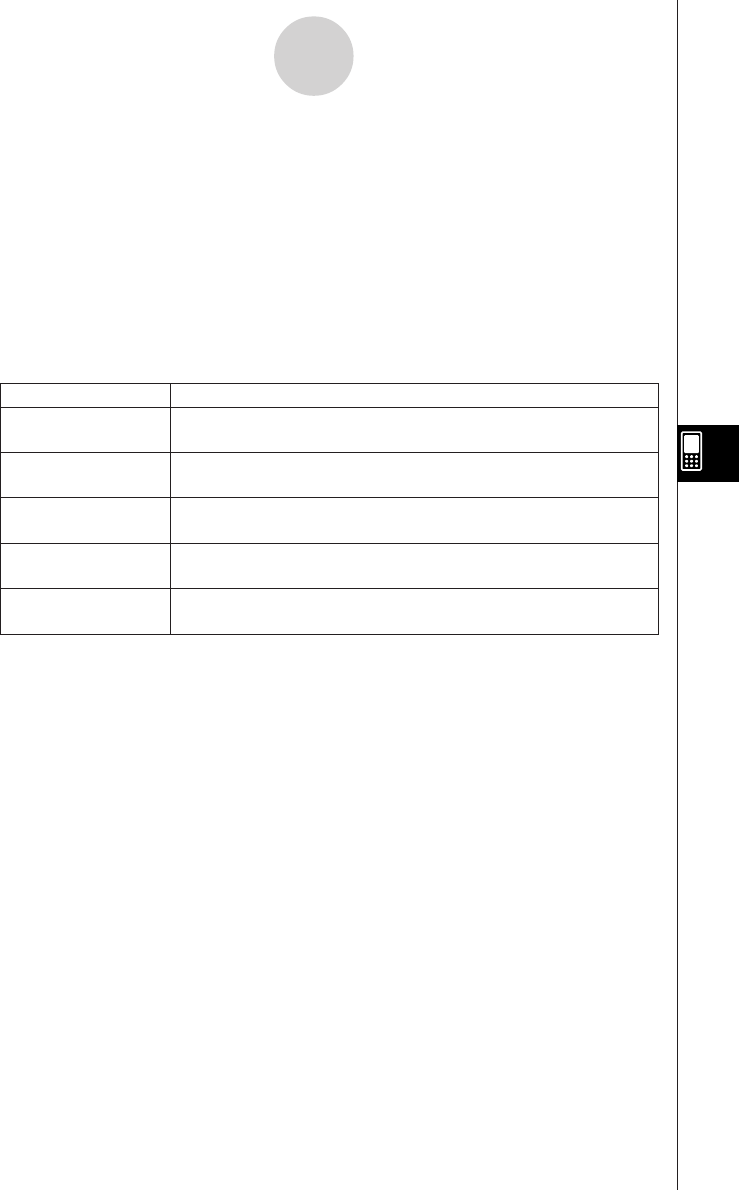User Manual
Table Of Contents
- Getting Ready
- Contents
- About This User’s Guide
- Chapter 1 Getting Acquainted
- Chapter 2 Using the Main Application
- 2-1 Main Application Overview
- 2-2 Basic Calculations
- 2-3 Using the Calculation History
- 2-4 Function Calculations
- 2-5 List Calculations
- 2-6 Matrix and Vector Calculations
- 2-7 Using the Action Menu
- 2-8 Using the Interactive Menu
- 2-9 Using the Main Application in Combination with Other Applications
- 2-10 Using Verify
- Chapter 3 Using the Graph & Table Application
- Chapter 4 Using the Conics Application
- Chapter 5 Using the 3D Graph Application
- Chapter 6 Using the Sequence Application
- Chapter 7 Using the Statistics Application
- 7-1 Statistics Application Overview
- 7-2 Using List Editor
- 7-3 Before Trying to Draw a Statistical Graph
- 7-4 Graphing Single-Variable Statistical Data
- 7-5 Graphing Paired-Variable Statistical Data
- 7-6 Using the Statistical Graph Window Toolbar
- 7-7 Performing Statistical Calculations
- 7-8 Test, Confidence Interval, and Distribution Calculations
- 7-9 Tests
- 7-10 Confidence Intervals
- 7-11 Distribution
- 7-12 Statistical System Variables
- Chapter 8 Using the Geometry Application
- Chapter 9 Using the Numeric Solver Application
- Chapter 10 Using the eActivity Application
- Chapter 11 Using the Presentation Application
- Chapter 12 Using the Program Application
- Chapter 13 Using the Spreadsheet Application
- Chapter 14 Using the Setup Menu
- Chapter 15 Configuring System Settings
- 15-1 System Setting Overview
- 15-2 Managing Memory Usage
- 15-3 Using the Reset Dialog Box
- 15-4 Initializing Your ClassPad
- 15-5 Adjusting Display Contrast
- 15-6 Configuring Power Properties
- 15-7 Specifying the Display Language
- 15-8 Specifying the Font Set
- 15-9 Specifying the Alphabetic Keyboard Arrangement
- 15-10 Optimizing “Flash ROM”
- 15-11 Specifying the Ending Screen Image
- 15-12 Adjusting Touch Panel Alignment
- 15-13 Viewing Version Information
- Chapter 16 Performing Data Communication
- Appendix

20050501
7-11-1
Distribution
7-11 Distribution
Though there are a number of different types of distributions, the one most commonly used
is the “Normal Distribution”, which is an essential type of distribution for statistical
calculations. Other types of distributions include the Poisson distribution and geometric
distribution. The type of distribution used depends on the type of data being handled.
The shape of a distribution makes it possible to determine trends in data somewhat. You can
specify a value and calculate the probability that any data value from the distribution is less
than the specified value. In other words, you can determine what percent from the bottom
that data value occurs within the distribution.
The following is a list of distributions and the description of what each one calculates.
Normal Probability
Density
DescriptionDistribution Name
Calculates the probability density of normal distribution from a
specified
x value.
Normal Distribution
Probability
Specifies two values and calculates the probability of normal
distribution data falling between them.
Inverse Cumulative
Normal Distribution
Specifies a cumulative probability and calculates the value at that
location in a normal distribution.
Student-t Probability
Density
Calculates
t probability density from a specified x value.
Student-
t Distribution
Probability
Specifies two values and calculates the probability of Student-
t
distribution data falling between them.
In addition to the above distributions, the ClassPad provides information on the
χ
2
distribution, F distribution, binomial distribution, Poisson distribution, and geometric
distribution. Commands to achieve this are described in the following section.










